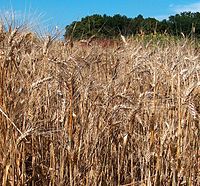
Photo from wikipedia
Global durum wheat consumption (Triticum durum Desf.) is ahead of its production. One reason for this is abiotic stress, e.g., drought. Breeding for resistance to drought is complicated by the… Click to show full abstract
Global durum wheat consumption (Triticum durum Desf.) is ahead of its production. One reason for this is abiotic stress, e.g., drought. Breeding for resistance to drought is complicated by the lack of fast, reproducible screening techniques and the inability to routinely create defined and repeatable water stress conditions. Here, we report the first analysis of dissection of yield and yield-related traits in durum wheat in Pakistan, seeking to elucidate the genetic components of yield and agronomic traits. Analysis of several traits revealed a total of 221 (160 with logarithm of odds (LOD) > 2 ≤ 3 and 61 with LOD > 3) quantitative trait loci (QTLs) distributed on all fourteen durum wheat chromosomes, of which 109 (78 with LOD > 2 ≤ 3 and 31 with LOD > 3) were observed in 2016-17 (S1) and 112 (82 with LOD > 2 ≤ 3 and 30 with LOD > 3) were observed in 2017-18 (S2). Allelic profiles of yield QTLs on chromosome 2A and 7B indicate that allele A of Xgwm895 and allele B of Xbarc276 can enhance the Yd up to 6.16% in control and 5.27% under drought. Moreover, if combined, a yield gain of up to 11% would be possible.
Journal Title: International Journal of Molecular Sciences
Year Published: 2020
Link to full text (if available)
Share on Social Media: Sign Up to like & get
recommendations!